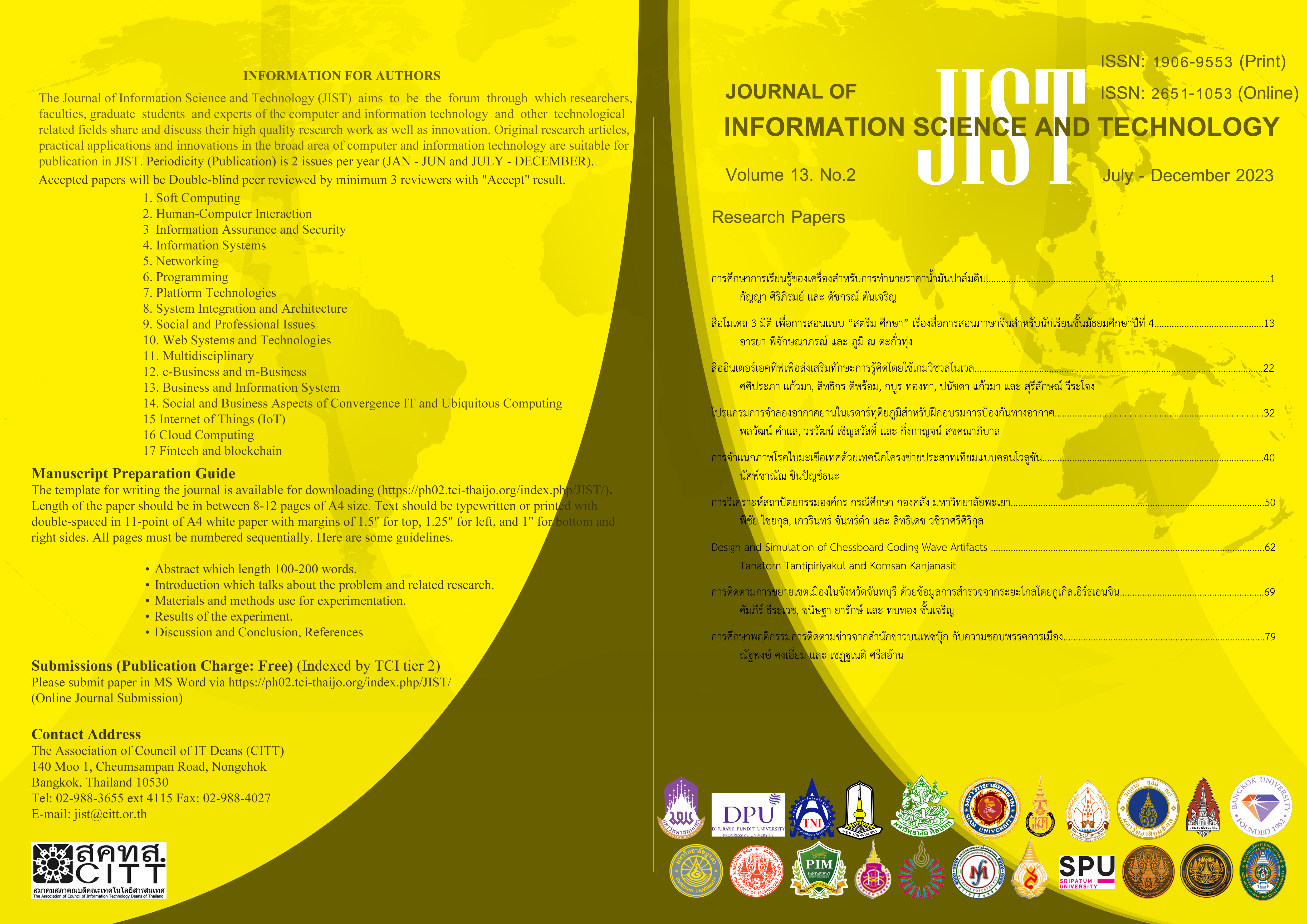การติดตามการขยายเขตเมืองในจังหวัดจันทบุรี ด้วยข้อมูลการสำรวจจากระยะไกลโดยกูเกิลเอิร์ธเอนจิน
Main Article Content
บทคัดย่อ
ข้อมูลการสำรวจจากระยะไกลโดยกูเกิลเอิร์ธเอนจินจำนวน 102 ภาพ จากดาวเทียม LANDSAT-5 TM และ LANDSAT-8 OLI ถูกใช้สำหรับจำแนกการใช้ที่ดิน 6 ประเภทย้อนหลัง 30 ปี ด้วยเทคนิคการเรียนรู้ของเครื่อง โดยอาศัยอัลกอริทึมป่าสุ่ม เพื่อวิเคราะห์การเปลี่ยนแปลงและศึกษารูปแบบการขยายเขตเมืองของพื้นที่ พบว่า พ.ศ. 2535 ถึงปี พ.ศ. 2555 มีการใช้ที่ดินสำหรับพืชผลไม้ล้มลุกและพืชไร่มากเป็นอันดับที่ 1 โดยมีพื้นที่ 3,404.96 ตร.กม. 2,596.02 ตร.กม. 2,404.79 ตร.กม. 2,604.32 ตร.กม. และ 2,623.44 ตร.กม. ในทุก ๆ 5 ปีตามลำดับ ในขณะที่ พ.ศ. 2560 และ พ.ศ. 2565 มีการใช้ที่ดินสำหรับพืชผลไม้ยืนต้นเป็นอันดับที่ 1 โดยมีพื้นที่ 2,695.83 ตร.กม. และ 2,516.83 ตร.กม. การขยายเขตของเมืองเพิ่มมากขึ้นสวนทางกับพื้นที่พืชผลไม้ล้มลุก พืชไร่ และพืชผลไม้ยืนต้นที่ลดลง การคาดการณ์ด้วยแบบจำลองซีเอ-มาร์คอฟ ชี้ให้เห็นแนวโน้มว่าใน พ.ศ. 2570 และ พ.ศ. 2575 จะมีการขยายตัวของพื้นที่เมืองและสิ่งปลูกสร้างเพิ่มขึ้นเป็น 115.15 ตร.กม. และ 126.02 ตร.กม.
Article Details
This work is licensed under a Creative Commons Attribution-NonCommercial-NoDerivatives 4.0 International License.
I/we certify that I/we have participated sufficiently in the intellectual content, conception and design of this work or the analysis and interpretation of the data (when applicable), as well as the writing of the manuscript, to take public responsibility for it and have agreed to have my/our name listed as a contributor. I/we believe the manuscript represents valid work. Neither this manuscript nor one with substantially similar content under my/our authorship has been published or is being considered for publication elsewhere, except as described in the covering letter. I/we certify that all the data collected during the study is presented in this manuscript and no data from the study has been or will be published separately. I/we attest that, if requested by the editors, I/we will provide the data/information or will cooperate fully in obtaining and providing the data/information on which the manuscript is based, for examination by the editors or their assignees. Financial interests, direct or indirect, that exist or may be perceived to exist for individual contributors in connection with the content of this paper have been disclosed in the cover letter. Sources of outside support of the project are named in the cover letter.
I/We hereby transfer(s), assign(s), or otherwise convey(s) all copyright ownership, including any and all rights incidental thereto, exclusively to the Journal, in the event that such work is published by the Journal. The Journal shall own the work, including 1) copyright; 2) the right to grant permission to republish the article in whole or in part, with or without fee; 3) the right to produce preprints or reprints and translate into languages other than English for sale or free distribution; and 4) the right to republish the work in a collection of articles in any other mechanical or electronic format.
We give the rights to the corresponding author to make necessary changes as per the request of the journal, do the rest of the correspondence on our behalf and he/she will act as the guarantor for the manuscript on our behalf.
All persons who have made substantial contributions to the work reported in the manuscript, but who are not contributors, are named in the Acknowledgment and have given me/us their written permission to be named. If I/we do not include an Acknowledgment that means I/we have not received substantial contributions from non-contributors and no contributor has been omitted.
เอกสารอ้างอิง
วรรโณบล ควรอาจ และ ผกามาศ ถิ่นพังงา, “กระบวนการกลายเป็นเมืองในประเทศไทย,” [ออนไลน์], 2556, เข้าถึงได้: https://www.tei.or.th/thaicityclimate/public/research -46.pdf. [เข้าถึงเมื่อ: 10 มกราคม 2566.].
UN, “World Population Prospects 2019: Data booklet”, [Online], pp. 2-4, 2019, Available: https://www.un.org.
development.desa.pd/files/files/documents/2020/Jan/un_2017_world_population_prospects-2017_revision_ databooklet.pdf. [Accessed on: Feb. 7, 2023.].
สำนักงานคณะกรรมการนโยบายเขตพัฒนาพิเศษภาคตะวันออก (สกพอ.), “ความเป็นมาของ อีอีซี,”, [ออนไลน์], 2566, เข้าถึงได้: https://www.eeco.or.th/th/ government-initiative. [เข้าถึงเมื่อ: 15 มกราคม 2566].
ปวีณา เปรมเจริญ, “การประยุกต์ระบบสารสนเทศภูมิศาสตร์ศึกษาการใช้ที่ดินในเขตเทศบาลเมืองแสนสุข จังหวัดชลบุรี,”, วิทยานิพนธ์ วท.ม. (ภูมิสารสนเทศเพื่อการจัดการ), บัณฑิตวิทยาลัยมหาวิทยาลัยเกษมบัณฑิต, กรุงเทพฯ, 2555.
กรีติ สงเอียด, “ปัจจัยที่มีผลต่อการใช้ประโยชน์ที่ดินเขตชายเมือง: กรณีศึกษาเขตตลิ่งชัน กรุงเทพมหานคร”, วิทยานิพนธ์ ผ.ม. (สาขาการวางผังเมืองและสภาพแวดล้อม), บัณฑิตวิทยาลัย มหาวิทยาลัย เกษตรศาสตร์, กรุงเทพฯ, 2555.
S. Sah, “Machine Learning: A Review of Learning Types,”, ResearchGate, no. July, 2020, doi: 10.20944/ preprints202007.0230.v1.
A. D. Kulkarni and B. Lowe, “Random Forest Algorithm for Land Cover Classification,”, Int. J. Recent Innov. Trends Comput. Commun., vol. 4, no. 3, pp. 58–63, 2016.
H. Guan, J. Yu, J. Li, and L. Luo, “Random Forests-Based Feature Selection for Land-Use Classification Using Lidar Data and Ortho-imagery,”, Int. Arch. Photogramm. Remote Sens. Spat. Inf. Sci., vol. XXXIX-B7, no. September, pp. 203–208, 2012, doi: 10.5194/ isprsarchives-xxxix-b7-203-2012.
Z. Zhang, G. Hörmann, J. Huang, and N. Fohrer, “A Random Forest-Based CA-Markov Model to Examine the Dynamics of Land Use/Cover Change Aided with Remote Sensing and GIS,” Remote Sens., vol. 15, no. 8, 2023, doi: 10.3390/rs15082128.
P. Chotchaiwong and S. Wijitkosum, “Predicting urban expansion and urban land use changes in Nakhon Ratchasima city using a CA-Markov model under two different scenarios,” Land, vol. 8, no. 9, 2019, doi: 10.3390/land8090140.
K. Kityuttachai, N. K. Tripathi, T. Tipdecho, and R. Shrestha, “CA-Markov analysis of constrained coastal urban growth modeling: Hua hin Seaside City, Thailand,” Sustain., vol. 5, no. 4, pp. 1480–1500, 2013, doi: 10.3390/su5041480.
S. Tonsiri, W. Arunpraparut, and W. Khunrattanasiri, “การคาดการณ์การเปลี่ยนแปลงการใช้ประโยชน์ที่ดินด้วยแบบจำลอง CA-Markov บริเวณเขตรักษาพันธุ์สัตว์ป่าเขาสอยดาว จังหวัดจันทบุรี,” vol. 37, no. 2, pp. 138–150, 2023.
C. Chompuchan and W. Taesombat, “การคาดการณ์การใช้ประโยชน์ที่ดินในลุ่มน้ำสาขาย่อยห้วยผาก จังหวัดเพชรบุรี ด้วยแบบจำลอง CA-Markov Land use forecasting in Huai Phak subbasin, Phetchaburi province using CA-Markov model,” no. July, 2020.
สำนักงานคณะกรรมการพัฒนาการเศรษฐกิจและสังคมแห่งชาติ, “แผนพัฒนาเศรษฐกิจและสังคมแห่งชาติ ฉบับที่ 12 พ.ศ. 2560-2564,”, [ออนไลน์], 2566, เข้าถึงได้: https://www.nesdc.go.th/ewt_dl_link.php?nid=6422, [เข้าถึงเมื่อ: 18 มกราคม 2566.].
N. Gorelick, M. Hancher, M. Dixon, S. Ilyushchenko, D. Thau, and R. Moore, “Google Earth Engine: Planetary-scale geospatial analysis for everyone,”, Remote Sens. Environ., vol. 202, pp. 18–27, 2017, doi: 10.1016 /j.rse.2017.06.031.
M. Amani et al., “Google Earth Engine Cloud Computing Platform for Remote Sensing Big Data Applications: A Comprehensive Review,”, IEEE J. Sel. Top. Appl. Earth Obs. Remote Sens., vol. 13, no. September, pp. 5326–5350, 2020, doi: 10.1109 /JSTARS.2020.3021052.
J.W. Rouse, R.H. Haas, J.A. Schell, and D.W. Deering, “Monitoring vegetation systems in the Great Plains with ERTS”, In: S.C. Freden, E.P. Mercanti, and M. Becker (eds) Third Earth Resources Technology Satellite–1 Syposium. Volume I: Technical Presentations, NASA SP-351, NASA, Washington, D.C., pp. 309-317, 1974.
Z. Yong, G. Jingqing, and S. Ni., “Use of normalized difference built-up index in automatically mapping urban areas from TM imagery,”, International Journal of Remote Sensing - INT J REMOTE SENS, 24, pp. 583-594, 2003, doi:10.1080/01431160304987.
M. S. Mondal, N. Sharma, P. K. Garg, and M. Kappas, “Statistical independence test and validation of CA Markov land use land cover (LULC) prediction results,” Egypt. J. Remote Sens. Sp. Sci., vol. 19, no. 2, pp. 259–272, 2016, doi: 10.1016/j.ejrs.2016.08.001.



